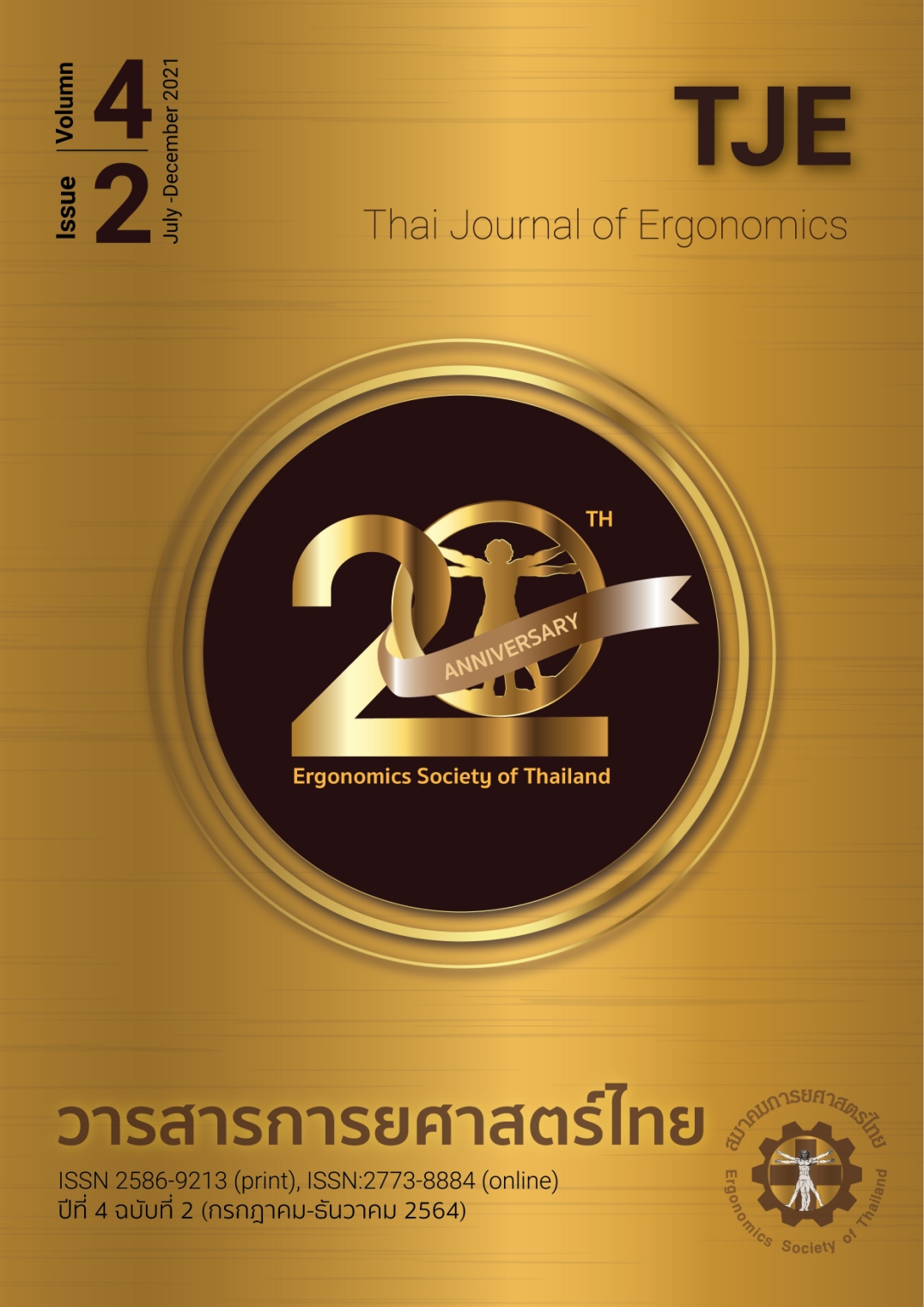ผลของการใส่และประสบการณ์ในการใช้เข็มขัดรัดหลังต่อน้ำหนักที่เหมาะสมสำหรับการยกในคนงานชาย: ประเมินโดยวิธีไซโคฟิสิกส์
Main Article Content
บทคัดย่อ
การทดลองภาคตัดขวางนี้มีวัตถุประสงค์เพื่อศึกษาผลของการใส่เข็มขัดรัดหลังและประสบการณ์การใส่เข็มขัดรัดหลังต่อน้ำหนักสูงสุดที่ยกได้ (MAWOL) โดยการประเมินการไซโคฟิสิกส์ คนงานชาย 30 คนอายุระหว่าง 18-30 ปี แบ่งเป็นกลุ่มที่ไม่มี (NE), จำนวน 15 คน และมีประสบการณ์ (E) 15 คน ในการใช้เข็มขัดรัดหลัง MAWOL อัตราการเต้นหัวใจ และ ความเหนื่อย (RPE) ถูกวัดที่ความถี่ของการยกที่ 4.3 ครั้ง/นาที ผลการทดลองพบว่าการใส่เข็มขัดรัดหลังและประสบการณ์การใส่เข็มขัดรัดหลังมีผลต่อ MAWOL การใส่เข็มขัดรัดหลังสามารถเพิ่ม MAWOL ได้ร้อยละ 8.7 และร้อยละ 12.0 ได้ ในกลุ่ม NE และ E ตามลำดับ ค่า MAWOL ของกลุ่ม E มีค่ามากกว่ากลุ่ม NE อย่างมีนัยสำคัญทางสถิติ อัตราการเต้นหัวใจของกลุ่ม E มีค่าน้อยกว่ากลุ่ม NE แม้ว่าผลการทดลองจะแสดงว่าการใส่เข็มขัดรัดหลังและประสบการณ์สามารถเพิ่มค่า MAWOL ได้ แต่ควรนำไปใช้อย่างระมัดระวังเพราะอาจทำให้คนงานรับรู้ความรู้สึกปลอดภัยที่ผิดพลาด นำไปสู่อาการบาดเจ็บของหลังได้
Article Details
References
Riihimaki H. Low-back pain, its origin and risk indicators. Scand J Work Environ Health. 1991;17:81-90.
Snook SH, Irvine CH. Maximum acceptable weight of lift. Am Ind Hyg Assoc J. 1967;28:322-9.
Kraus JF, Schaffer KB, Rice T, Maroosis J, Harper J. A field trial of back belts to reduce the incidence of acute low back injuries in New York City home attendants. Int J Occup Environ Health. 2002;8:97-104.
Kraus JF, Brown KA, McArthur DL, Peek-Asa C, Samaniego L, Kraus C. Reduction of acute low back injuries by use of back supports. Int J Occup Environ Health. 1996;2:264-73.
Wassell JT, Gardner LI, Landsittel DP, Johnston JJ, Johnston JM. A prospective study of back belts for prevention of back pain and injury. JAMA. 2000;284:2727-32.
van Poppel MNM, de Looze MP, Koes BW, Smid T, Bouter LM. Mechanisms of action of lumbar supports: a systematic review. Spine (Phila Pa 1976). 2000;25:2103-13.
van Duijvenbode ICD, Jellema P, van Poppel MNM, van Tulder MW. Lumbar supports for prevention and treatment of low back pain. Cochrane Database Syst Rev. 2008;2008:CD001823.
McCoy MA, Congleton JJ, Johnston WL, Jiang BC. The role of lifting belts in manual lifting. Int J Ind Ergon. 1988;2:259-66.
Reyna JR, Jr., Leggett SH, Kenney K, Holmes B, Mooney V. The effect of lumbar belts on isolated lumbar muscle. Strength and dynamic capacity. Spine (Phila Pa 1976). 1995;20:68-73.
Lavender SA, Kenyeri RON. Lifting belts: a psychophysical analysis. Ergonomics. 1995;38:1723-7.
Peeradajmontree O. Maximum acceptable weight of lifting in Thai male workers age 18-30 years: psychophysical approach [Thesis]. Bangkok: Mahidol University; 2002.
Jackson AS, Sekula BK. The influence of strength and gender on defining psychophysical lift capacity. Proc Hum Factors Ergon Soc Annu Meet. 1999;43:723-7.
Häkkinen K, Newton RU, Gordon SE, McCormick M, Volek JS, Nindl BC, et al. Changes in muscle morphology, electromyographic activity, and force production characteristics during progressive strength training in young and older men. J Gerontol A Biol Sci Med Sci. 1998;53:B415-23.
Folland JP, Williams AG. The adaptations to strength training: morphological and neurological contributions to increased strength. Sports Med. 2007;37:145-68.
Bobick TG, Belard J-L, Hsiao H, Wassell JT. Physiological effects of back belt wearing during asymmetric lifting. Appl Ergon. 2001;32:541-7.
Marley RJ, Duggasani AR. Effects of industrial back supports on physiological demand, lifting style and perceived exertion. Int J Ind Ergon. 1996;17:445-53.
Rafacz W, McGill SM. Wearing an abdominal belt increases diastolic blood pressure. J Occup Environ Med. 1996;38:925-7.
Mital A, Foononi-Fard H, Brown ML. Physical fatigue in high and very high frequency manual materials handling: perceived exertion and physiological indicators. Hum Factors. 1994;36:219-31.

